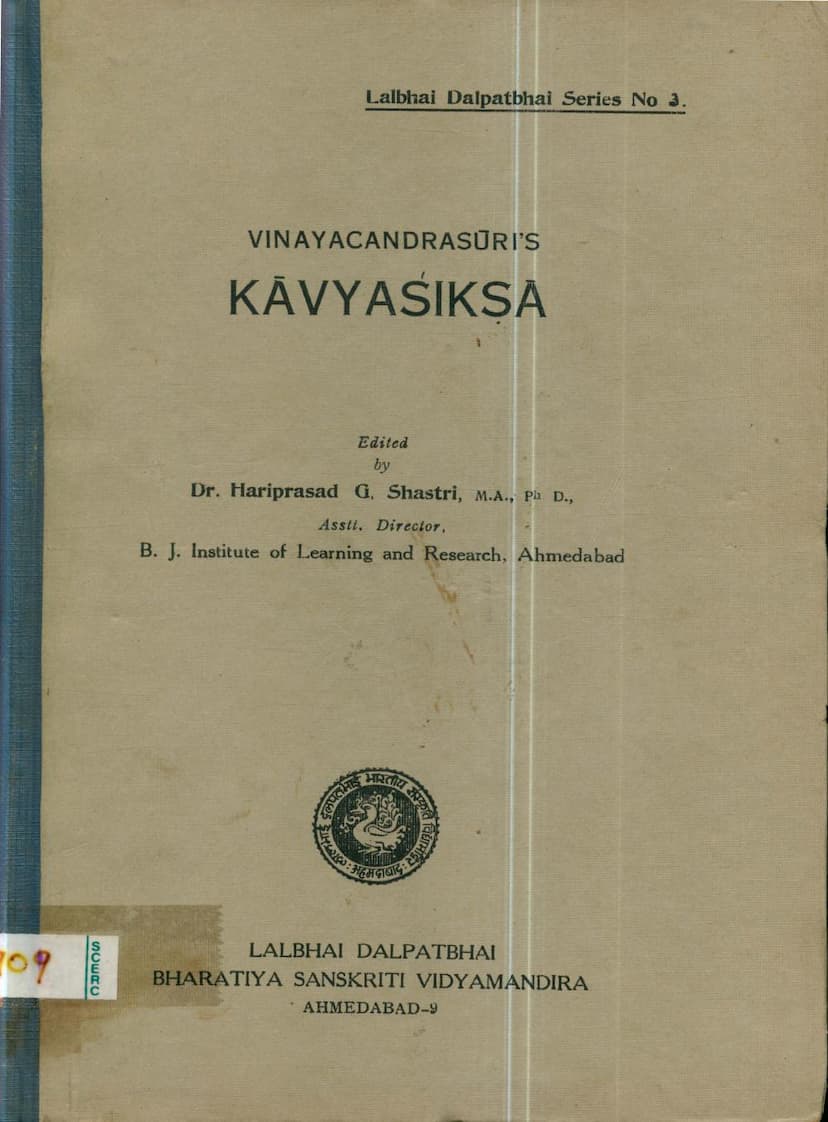Kavyashiksha
Added to library: September 2, 2025

Summary
"Kavyashiksha" (Education in Poetry) by Acharya Vinayachandra, edited by Dr. Hariprasad G. Shastri, is a significant Jain text published in 1964 as part of the Lalbhai Dalpatbhai Series. The work, dating from the latter half of the 13th century, serves as a foundational guide for aspiring poets, focusing on the practical aspects of composing poetry in both verse and prose.
The "Kavyashiksha" is structured into six "Paricchedas" (chapters):
-
Paricchedas I (Siksha-pariccheda): This introductory chapter lays down the basic principles of poetry composition. It defines "kavya" (poetry) and discusses the importance of "siksas" (instructions). The author elaborates on various poetic techniques, including the description of existing and non-existing phenomena, the use of different meters, the portrayal of colors, shapes, qualities, and the overall structure of a "mahakavya" (epic poem).
-
Pariccheda II (Kriya-nirnaya): This chapter focuses on the critical decision-making regarding verbs. It enumerates numerous verbs, presenting their roots, meanings, and grammatical classifications, emphasizing the importance of precise verb usage in poetry.
-
Pariccheda III (Lokakausalya-pariccheda): This chapter delves into worldly knowledge and common practices ("lokakausalya"). It provides encyclopedic information on various subjects, enumerating entities, collective nouns, geographical regions, and important sayings ("abhanikas") in Sanskrit and Prakrit. The author illustrates poetic compositions by drawing examples from renowned works, including prose passages from Bana Bhatta's "Harsacarita," and explores techniques like the repetition of similar syllables and various similes.
-
Pariccheda IV (Bijavyavarnana): This chapter deals with "bijas," which can be understood as potent or seed-like elements in poetry. It provides examples of descriptions related to religious figures (Jina, Hara, Brahma, Hari) and explores figures of speech like metaphor and hyperbole.
-
Pariccheda V (Anekarthashabda-sangraha): This is a lexicographical chapter dedicated to homonyms ("anekarthas"), words with multiple meanings. The author meticulously classifies and presents these words, arranged by syllable count, starting with single-syllable words and progressing to five-syllable words, and also covers indeclinables ("avyayas") and individual letters of the alphabet.
-
Pariccheda VI (Rasabhava-nirupan): This chapter expounds on "rasas" (aesthetic sentiments) and "bhavas" (emotional states). It covers the nine primary rasas, their corresponding "sthayi bhavas" (dominant emotions), and the thirty-three "vyabhicari bhavas" (transitory emotions). The manuscript unfortunately ends abruptly while discussing the "sattvika bhavas" (bodily expressions of emotion).
Key aspects of the "Kavyashiksha":
- Pedagogical Approach: The work is primarily intended for beginners, making the entry into the art of poetry accessible by providing fundamental information.
- Influence of Predecessors: Acharya Vinayachandra draws heavily from earlier scholars, most notably Acharya Hemachandra, whose works like "Kavyanusasana," "Abhidhanacintamani," and "Anekarthasamgraha" significantly influenced the "Kavyashiksha." He also acknowledges inspiration from Bappa Bhatti and Bana Bhatta.
- Content Breadth: The text covers a wide range of topics crucial for poetry, including grammar, vocabulary, prosody, figures of speech, sentiments, and worldly knowledge. The inclusion of extensive lists of words, figures of speech, and classifications highlights the author's meticulous approach.
- Editing and Publication: The L. D. Institute of Indology in Ahmedabad undertook the publication of this rare and incomplete manuscript, made possible by a grant from the Ministry of Education, Government of India. Dr. H. G. Shastri, with the assistance of Muni Shri Punyavijayaji, meticulously edited the text, striving for accurate readings despite the manuscript's limitations.
- Author Identification: Acharya Vinayachandra is identified as the author of twenty "Prabandhas" and the "Mallisvamicarita" (published as "Mallinathacaritra"). His literary activities are placed in the 13th century CE.
In essence, "Kavyashiksha" is a comprehensive and lucid manual that aims to equip aspiring poets with the essential knowledge and practical skills needed to master the art of poetry, reflecting the rich tradition of Jain scholarship in literary arts.